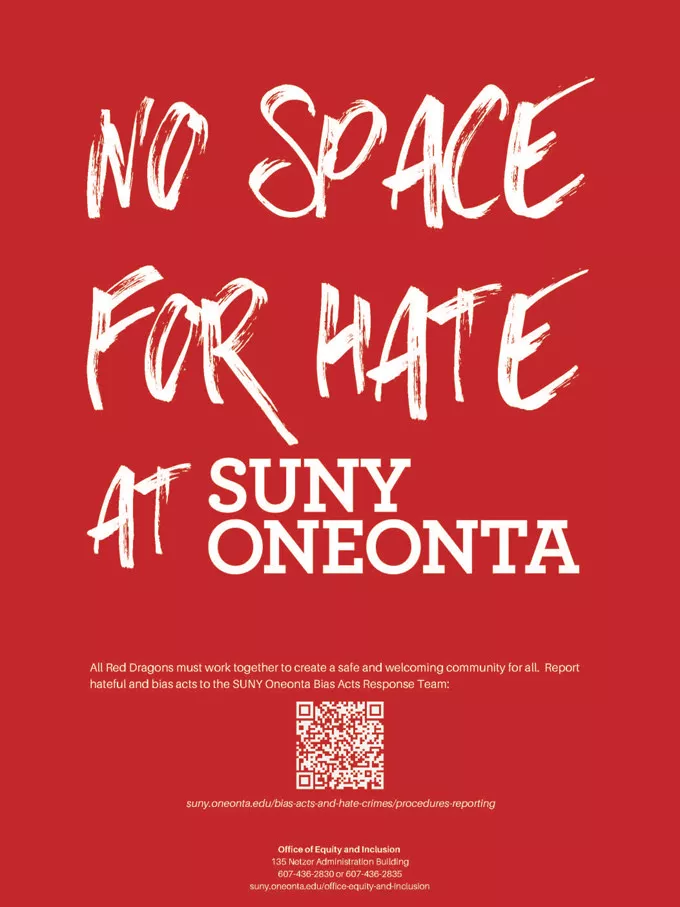Reporting and Response Procedure for Bias Act Response Team (BART)
Filing a Complaint: The reporter can choose whether or not to remain anonymous.
Reporting Options include:
- Anonymous
- Not anonymous but declined to be contacted
- Not anonymous and can be contacted
Who can file a Complaint?
- The target
- A witness
- An ally
- SUNY Oneonta students, employees, guests, and others with knowledge of a bias act connected to the SUNY Oneonta community
Ways to file a Complaint with BART.
- Online – Through the website reporting link– Anonymous or Not
- Contact a BART member listed here. You may contact members by email, phone, or in person.
Timeline:
- Non-anonymous report: the reporter will receive a follow up email within two business days
- Anonymous report: follow up contact to reporter will not occur
Number of BART members to review a report:
- Each submitted report will be reviewed by up to 3 BART members.
- Each reporter has the option to select one member to serve in the review process.
Review Process
Anonymous Reporter
- You will not be contacted.
- Complaint will be reviewed by the Co-chairs and any other BART member that you selected when submitting the report.
Non-Anonymous Reporter Who can be Contacted
- Upon receipt of a complaint the co-chairs will forward the report to the BART member the reporter selected as well as to two additional members. (A total of three members).
- If the reporter did not choose a BART member when the report was submitted, the co-chairs will identify three members to send the report to. One of the members will be designated as the lead person and will be the point person throughout the process.
- Within two days of receipt of complaint, the reporter will receive an email confirming receipt of the report and with a request to schedule a meeting.
- Purpose of meeting:
- Gather additional information about the complaint, including information about the perpetrator(s) if identified.
- Discuss all options available to address the filed complaint; this includes directing the report to other offices, including the OEI.
Expectations from the BART Review Process
BART is not an investigatory body. If allegations suggest a possible violation of criminal law, the student code, or the discrimination policy, the report will be forwarded to the proper office. BART serves as a resource for prevention/education, victim support, and referrals.
Options to address complaints include:
- Educational Programs including trainings
- Various conflict resolution models (e.g., restorative justice, peacemaking circles, or intergroup dialogue)
- Cross-departmental collaborations
Closing the Loop
- Completion of a short evaluation survey - Provide feedback on the process, and outcome. This data is important for continuous improvement of the process
Communication
- Lead Team member will share the information with the Co-chairs to close the report.
- A summary with no identifiable information will be shared with the rest of BART members at the next meeting following the conclusion of the complaint.
- Monthly summary of reports will be shared with the CDO
- Data will be used to improve climate through trainings, programming etc.
- A summary of reports will be published each semester.
Some bias incidents may rise to the level of criminal offenses. While these may be reported to BART, they may also be reported to University Police, particularly in cases of emergency. If you wish to contact University Police, you may do so by calling 607-436-3550 or by reporting anonymously through silent witness. Below are some examples of bias incidents that could be criminal and tips on how you may respond:
- Do not erase or clean it. Contact University Police immediately at 607-436-3550 so that an officer will take photographs and/or record the contents of the graffiti, as well as collect any other evidence available.
- If you cannot remain at the scene until an officer arrives, cover any graffiti/evidence with a piece of paper. Write on the paper that UPD was called and give the date and time of your call. This will prevent others from seeing it and making additional calls or erasing the evidence.
- If you are told by someone that they observed bias related graffiti, you or the person who told you should contact University Police. However, if you are told that the evidence of this graffiti has been cleaned or erased you should contact the Office of Student Affairs and provide as much information as you have about the time and place the graffiti was seen.
- Do not attempt to clean or repair the damage.
- Contact University Police immediately at 607-436-3550 for an officer to collect evidence and record the damage. University Police and/or Residence Life may contact an emergency maintenance staff member if the damage makes a structure unsafe.
- Students – contact University Police immediately at 607-436-3550 and provide detailed descriptions of what happened, what was said, who was involved, and where it occurred. Also include names of any witnesses.
- Employees – Please follow the Workplace Violence policy. This policy directs you to discuss the incident with your supervisor who will then contact the Chief of University Police and Human Resources for investigation, follow-up, and support as needed. For additional information, you may also refer to the Discrimination Policy.
- Contact University Police immediately at 607-436-3550 for medical evaluation and assistance by dialing 911 from any campus phone or 607-436-3550 from a cell phone. For employees, this falls under the Workplace Violence policy. A University Police Officer will direct you regarding how to proceed.
